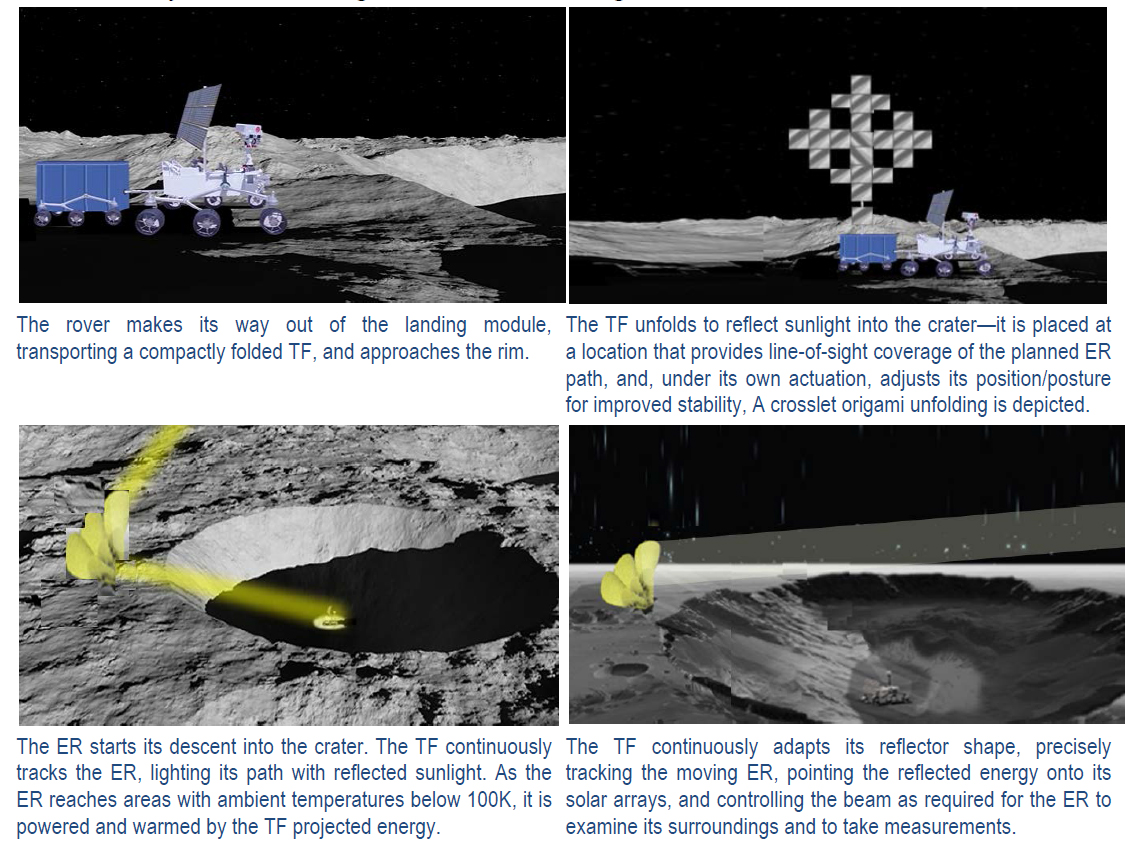Adrian Stoica
NASA Jet Propulsion Laboratory
Description
Imagine an oasis of warm sunlight surrounded by a desert of freezing cold darkness. Robots inside the oasis perform scientific lab analyses and process icy regolith brought from excavations in the neighboring darkness. This oasis, about the size of a football field, lies in a valley about twice the size of Washington DC, surrounded by peaks the size of Mount Rainier. From its low angle on the horizon, the sun’s rays never shine over the peaks into the valley, until heliostats unfold on these peaks and redirect the rays down to form the oasis of sunlight. This place becomes a large science laboratory and the largest off-Earth producer of liquid hydrogen and liquid oxygen for fueling inter-planetary trips. This is the Shackleton crater at the lunar South Pole and TransFormers are the heliostats projecting sunlight onto the oasis. This is the vision we propose to bring to life. The TransFormer (TF) concept is a paradigm shift to operating in Extreme Environments (EE). TF are systems that direct energy into energy-depleted (extreme) environments, transforming them, locally, around robots or humans, into mild micro-environments. The robots would no longer need to cope with the cold darkness, covered by blankets and warmed by the heat of RTGs.The analysis determined that it is possible to power and keep warm an MSL-class exploration rover 10km away in the Shackleton crater (SC), and calculated the required TF size (40m diameter for a circular reflector). An unanticipated finding was the understanding that such a reflector could power not only a single rover, but hundreds of MSL-class rovers operating in a sunlit oasis (which receives in total over 1MW from the 40m diameter reflector). It could power and warm up small rovers or devices that cannot carry RTGs. This insight encouraged the team to propose for Phase II the more ambitious mission scenario described above, not only creating a micro-environment around a single exploration rover, but forming an entire “oasis” where equipment for in-situ resource utilization (ISRU) can also operate! The proposed mission scenario limits the illuminated area to the carefully selected oasis location, where the ISRU equipment operates and where the excavating robots operating nearby in the darkness come back to warm up and recharge. Another new concept in this proposal was triggered by an insight during the recent NIAC Workshop of a rover “chasing” sunlight around the South Pole. There is always at least one point on the crater rim that receives sunlight. Indeed, by looking at two appropriately selected points around SC, the collective illumination time increases from 86% to 94% (Bussey, 2010). As Wettergreen suggests, it appears possible to have continuous collective illumination over multiple points. The new idea is to place TFs at these points, at least one illuminated at all times even though others may have dimmed. This way, increasing the time of continuous illumination becomes possible (no need to “chase” the sunlight – just place TFs at key points along the way, and reflect it wherever needed). We will explore this idea, which for the first time points to the possibility to develop a Continuous Solar Power Infrastructure at the South Pole dispersed around SC, forming a true ‘ring of power’. The first objective is to advance the TF concept in the context of a lunar mission at Shackleton crater, to power, heat and illuminate robotic operations inside SC to prospect/excavate lunar volatiles in icy regolith, and to perform in-situ resource utilization (ISRU) of icy regolith in order to extract water, hydrogen, and oxygen. The second objective is to advance the feasibility of TFs by performing a point design of a scalable TF that packs in a cube of less than 1m on the side, weights 10–100 kg, unfolds to over 1,000 m2 of thin (0.1 to 1 mm) reflective surface with over 95% long-term reflectivity and is robust to dust obscuration.




























